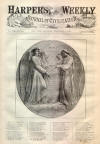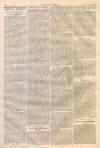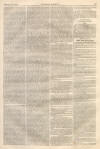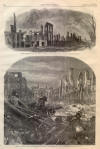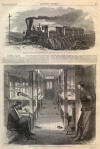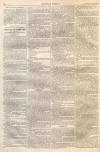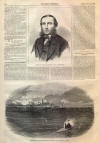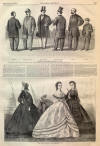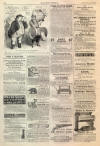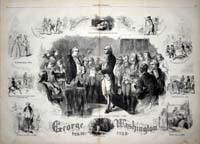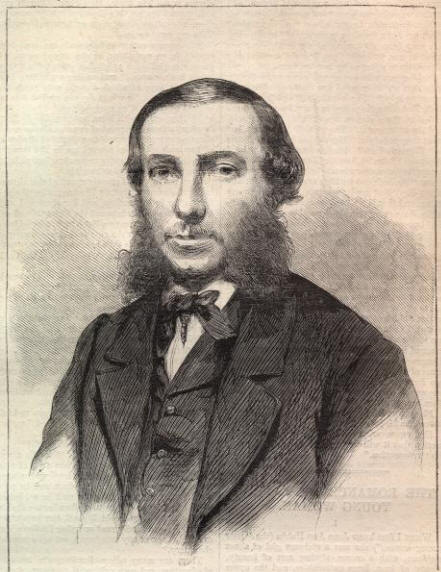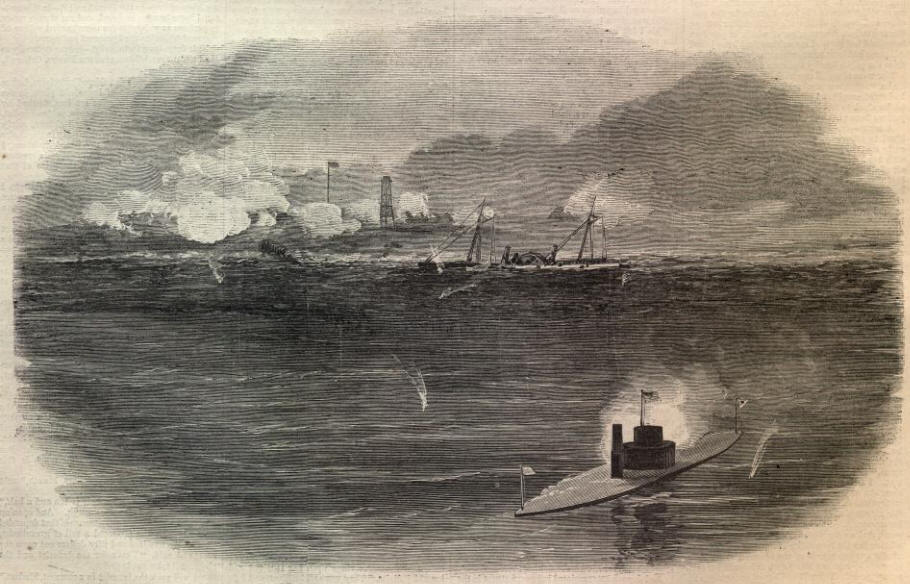Sullivan's Island
|
|
This Site:
|
HARPER'S WEEKLY. [FEBRUARY 27, 1864. 140 EDWARD W. GREEN.—[PHOTOGRAPHED BY MR. R. J. CHUTE, BOSTON.]"No, you needn't," replied Mrs. W. "I guess I'll put it on. It'll carry easy that-a-way." And suiting the action to the word, she clasped the glittering trophy round her wrist, and walked majestically out of the place. The cheap jewelry period has expired, thought I. "Do you know that lady ?" asked I of the salesman, whom I knew quite well. "No, do you know her, Mr. Tomkins? She has a smack of 'shoddy' about her, I should say." "Probably," I answered; "or the equivalent of shoddy. Her name was Jaynan Hubbs when I first knew her, and her mother was my laundress. Subsequently she married a 'boss' soap-fat man, as I was told, of the name of Weevil, and—" "Weevil!" exclaimed the salesman. "Why, that's the man that has made such a pile of money out of a contract for the hides, hoofs, and the other remains of the slaughtered cattle of one of our armies. He's just bought Ducksandrake's splendid house out, Gooseberry Street, you know, and they're going to give a tremendous opening ball or soiree, or something, next week." "What, at this season?" "Oh! they'll find plenty of people to go. Besides, now I remember, it's a matinee, by-the-by. So he was a soap-fat man, eh? Ha! ha! ha!" Two days after this little incident I received, very much to my surprise, the following card, splendidly embossed and engraved in bronzed letters "old English" style: Mr. and Mrs. Weeville AT HOME May the —th, from 2 till 6 P.M. [RECEPTION AND BANQUET.] No. 5 Gooseberry Street. I did not go, however. My afternoon, that day, was spent in one of the Soldiers' Hospitals, where I wrote sixteen letters from sixteen poor fellows to their families. It wasn't as brilliant an entertainment as I should have enjoyed at Mrs. Weevil(le)'s, probably. But quite as useful and instructive, I fancy. At any rate, I don't regret my absence from the one, nor my presence at the other scene of our domestic drama. Here ends, for the present, my "ROMANCE OF A POOR YOUNG WOMAN." THE MALDEN BANK MURDER.THE murder of FRANK CONVERSE, on the 15th of last December, by EDWARD GREEN, whose portrait is given herewith, has excited the most intense interest. The murder was committed in the prosperous village of Malden, a few miles out of Boston, on the Boston and Maine Railroad. It was done at noonday, in a Bank, situated in the business part of the town, and yet so secretly that it left no trace of the doer, and the murderer passed from the banking-office to his own place of business, with no more suspicion attaching to him than to any other man at that time walking the streets of Malden. The victim was a boy of seventeen, son of the President of the bank, and was alone in the directors' room, in charge of $5000, which had just been counted out to him by the cashier for business use. The murderer having made a visit to the bank earlier in the day for the purpose of reconnoissance, immediately upon the departure of the cashier returned, and finding young Converse alone, drew from his pocket a six-shooter, and, placing the muzzle within a foot of the boy's head, fired, the ball entering back of the ear; another discharge was then lodged in the temple of the victim, who had fallen to the floor. To secure the bills in the drawer was the work of a moment, and the next the murderer mingled with the innocent passengers on the street. That a murder and robbery had been committed was all that transpired at the time. About three weeks afterward certain suspicious circumstances led to the apprehension of Mr. Bailey, who, upon examination, was acquitted. The name of the real murderer was not mentioned or thought of in connection with the crime: he was not one of the witnesses on Bailey's case, nor was he even mentioned in the inquest. But the "miraculous organ" through which the secret of murder always finds its way into publicity speaks through silence no less surely than through overt expression; and, in this case, the fact that there was one individual—the Postmaster of Malden—who never showed any interest in the murder, nor in the most casual manner ever mentioned it, drew the attention of two detectives, Heath and Jones, who were determined to ferret out the criminal, and also of several prominent citizens. His utter silence was the beginning of the net which soon began to close about the murderer. The other steps followed rapidly after, and as a natural consequence. The bills which had been taken were all of the Malden bank; the Postmaster was known to be involved in debt, and this would doubtless have been the motive leading to the crime. Totally unaware of suspicion, and placed, as it seemed, by his responsible position in society beyond all chances of suspicion, he would venture to pass, at least in Boston, a considerable amount of the plunder in payment of his dues. He was watched by a special detective every time he came to the city; and, step by step, the suspicions which had been aroused ripened into conviction. He had paid a debt of $700 in Malden Bank bills, and other debts of $20 and under in the same money. This, taken in connection with the remarkable silence of Green on the subject of the murder, furnished indubitable proof of his guilt, and he was arrested Sunday evening, February 7, at the residence of Mr. Lamson, whether he had been invited. He exhibited very little feeling, but confessed his guilt as soon as he found that he had been watched for the last month, and informed the detectives that they would find the rest of the money, part of it in the post-office, where it was concealed in an old boot, and the remainder in the attic of the Volunteer Fire-Engine House. The arrest of Green caused considerable surprise among his fellow-citizens, who had reposed the most complete trust in him for years. The photograph which we give was taken about a fortnight after the murder—over a month previous to his detection. Green is a young man of between twenty-seven and twenty-eight years of age, and rather short in stature. He has a wife and infant child. His wife is an estimable lady, and the fate of her husband excites in her the most heart-rending grief of which a true and honorable woman is susceptible.
SHELLING OF A
BLOCKADE-
|
||||||||||||||||||||||
|
|
||
|
|
Site Copyright 2003-2018 Son of the South. For Questions or comments about this collection, contact paul@sonofthesouth.net |
|
|
Are you Scared and Confused? Read My Snake Story, a story of hope and encouragement, to help you face your fears. |
||
